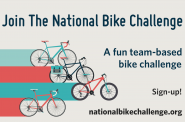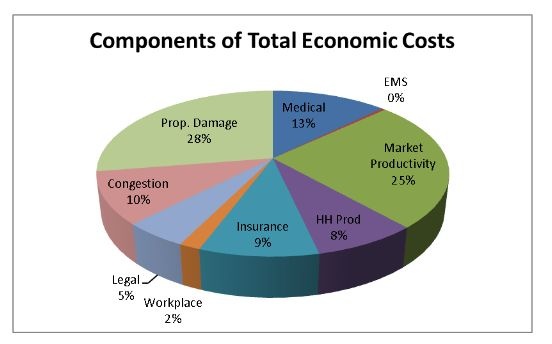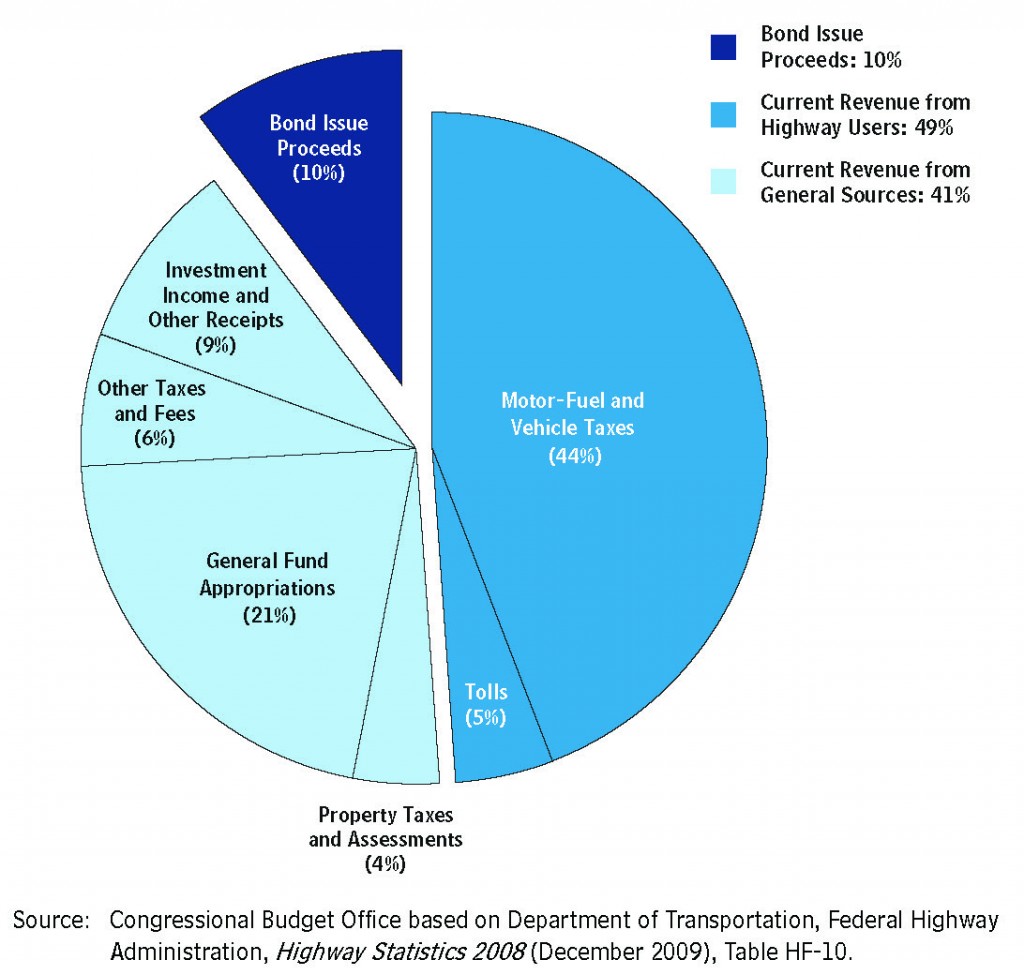The Massive Cost of Automobiles
Counting the cost of car crashes, the total bill for auto transit is about $1 trillion a year.
According to a recent study by the National Highway Safety Administration, in 2010, car crashes cost our country $871 billion, or about $900 for every man, woman and child. Of course, none of our children pay taxes or insurance premiums, so the real cost to folks like you and me, is much higher, whether you drive a car or not. Remember that figure the next time someone tells you people who ride bicycles or take transit don’t pay their fair share.
It is difficult to appreciate how much money $871 billion is. To put it in perspective, according to the Us Dept. of Transportation and the Congressional Budget Office, that same year, federal, state and local governments combined spent somewhere between $100 and $160 billion, and that included $12 billion in American Recovery and Reinvestment Act dollars. Other taxpayer watchdog groups claim a combined total of just over $300 billion for highways, bridges and local roads.
Everyone agrees that gas taxes and other user fees contribute less than half of what the feds spend in the Highway Trust Fund. The rest is made up from other sources, such as general fund appropriations, bonds, tolls and property taxes. And even after taxpayers bailed out it out with another $10 billion transfer earlier this year, the Highway Trust Fund is projected to begin running a deficit this summer, sometime in August. Given the gridlock in Washington, D.C. and the current political dislike of increased taxes, I suspect our elected leaders will kick the can down the road with another short-term injection of funds from the general fund rather than solve our transportation funding crisis.
Lets put this in round numbers. Including crashes, we spend somewhere north of a trillion dollars a year so people can drive, but we only collect about $50 billion a year in fuel taxes and other user fees. Let’s say transit gets $10 billion (rounding up), and bicycling and walking only get about $650 million. That amounts to less than 2% of the Federal Highway Administration budget, and only .065%, literally a drop in the ocean if you include the cost of crashes.
But hey, this is still America, right? Despite the fact that people are driving less, if most Americans still prefer to jump in a car by themselves to go anywhere, even trips of a mile or less, that is their right, isn’t it? Who cares how much it costs? If we just stopped subsidizing transit and made those self-righteous bicyclists pay their way, our transportation funding problems would go away, right?
This article was originally published by the Bicycle Federation of Wisconsin.
Bike Czar
-
Join a Bike Ride Under the Polish Moon
 Jun 1st, 2018 by Dave Schlabowske
Jun 1st, 2018 by Dave Schlabowske
-
9 Reasons to Join National Bike Challenge
 May 4th, 2018 by Dave Schlabowske
May 4th, 2018 by Dave Schlabowske
-
Biking Through the Mindoro Cut
 Apr 27th, 2018 by Dave Schlabowske
Apr 27th, 2018 by Dave Schlabowske

























Dave, you are still missing the boat in your bike and transportation funding arguments. As long as you continue to pit cars vs everything else you’re going to continue to get backlash. I support increased funding on transportation infrastructure and biking… yet these kinds of things just make me roll my eyes. Your best bet is to separate the arguments and support transportation and bike resources on their own. (Just as you should with fighting highway infrastructure spending or whatever other funding you’re against)
Small potatoes when you compare the numbers you discuss to lost productivity in the event the majority of people switched to biking. It is a wonderful form of transportation to those who have the time to be able to bike everywhere. For most people in their day-to-day, it is impossibly impractical.
I would love to see a mother of three trying to shuttle groceries home for the week on a bike.
Buses and bicycles use many of the same roads that cars do. Investing in roads is investing in transit and cycling.
I would be curious to see how much the people taking advantage of welfare and unemployment are costing our country. Or how much the people on “disability” are costing our country.
I recently drove from New York City to Milwaukee after not using the interstate highway system for about a decade, and I’m baffled that people consider that a reasonable way to travel. People on the coasts refer to this region as “flyover country” and–condescension aside–there’s truth to that nickname. These cities are practically inaccessible.
This is what you have to deal with in order to drive from NYC to Chicago:
– Obtain automobile
– MANUALLY operate and maintain the thing for ~13 hours
– No idea how long it will take (traffic, construction, accidents, etc.)
– No idea how much it will cost (tolls, gas, etc.)
– Vigilantly avoid personal injury/property damage (drunks, dangerous roads, etc.)
The time, risk, cost and uncertainty is incredible. Add to that rising energy costs, the dysfunctional economy and the fact that people are driving less, I can’t imagine this system has much life left in it.
Like corporate welfare? It’s a lot. Billions. That must enrage you, knowing that all those rich corporations are exploiting loopholes and accepting handouts that cost taxpayers billions of dollars each and every year.
Businesses that use those handouts to employ/expand their business/workforce? I’m all for using taxpayer money for things that create jobs.
Inner city bums (there, I didn’t call them thugs) that live off my tax money and still can’t feed their kids because they are too busy spending their handouts on new clothes and rims. That refuse to find jobs because the president has made this mooching form of lifestyle acceptable and even encouraged it?That’s the unnecessary welfare I’m talking about.
@Rory….Why would you drive from NYC to Milwaukee? Wouldn’t you fly?
I find Milwaukee perfectly accessible. I’ve lived here my whole life. I also find Chicago perfectly accessible.
People need cars, roads, and freeways and will continue to do so for the rest of your life. That is just something you need to deal with.
@Justin That was partly my point. The only reasonable travel mode in this country is air.
And of course Milwaukee is accessible to people who are already here. To outsiders it’s non-existent. There’s a lot of talk on this site about rejuvenating downtown and so on, but where do you think those people and that money is going to come from? It’s flying back and forth over our heads.
I think you overestimate people’s need and desire for cars at this point, especially millenials. I realize they’re not going to go out and dig the whole interstate system up and replace it with trains, but it’s unlikely this generation will continue to fund it at current levels.
Scotty, concrete head, Walker decided that concrete was more important than education. Over $1 billion for the Zoo interchange. Road building jobs are short term and employee limited numbers of people.
Oh and by the way, Justin, you’re a right wing bigot.
Like other articles Dave has posted this is why bike advocates will never be taken seriously. As Andy points out it’s foolish to try and compare spending on cars versus spending on bikes.
We NEED roads to not only have individuals transact business but you also see a ton of semis moving goods as well.
When you have people like me who rides my bike a lot rolling their eyes you can only imagine what the general population is doing.
No one is saying we don’t need roads, but the majority of people believe that the gas tax pays for them. That’s not true, they’re heavily subsidized. Every time we debate whether or not we need a more balanced transportation system, inevitably we hear that we don’t want trains because they don’t pay for themselves. Roads don’t come close. Road builders and the DOT get very little scrutiny. We’ll spend billions without really knowing or caring if it’s needed. Transportation is now a partisan debate as noted by the crazy comments by Justin. The article is about the reuse costs of driving, not about “inner city bums” as he called them. We need transportation choices. More options will have positive social impacts and may even save usenet in the long run.
Rory, you are applying an awfully narrow point of view onto a scenario that goes far beyond your limited understanding. Despite individual miles driven being down since the recession, the overall number of miles driven is higher than ever before. And despite “millennial’s” having a lower percentage of car ownership, the percent who own or plan to own a car within two years is still well over 90%. All of this hardly leads us to believe cars and instates are going anywhere.
Most people make logistical decisions based on what is best for their own circumstances. I don’t know many people that think driving themselves from NY to Milwaukee makes much sense… but for a large chunk of our interstate commerce that does make sense. Often air, pipe, or rail (including intermodal) transport just doesn’t make sense. Same with a family of four who can’t afford to fly but taking the bus is not feasible… or someone making an intermediate length trip… or the person who needs to make several stops along a route… There’s many other situations where it does make sense so it is odd that you base your view on transportation off of your own single road trip experience.
Cars are not going to disappear, no doubt, but the trends still point to a significant drop in automobile ownership and use. Some stats:
-In 2011, boomers were 15 times more likely to purchase new vehicles than young millennials (ages 18 to 24), and even consumers ages 75 and up have been buying cars at higher rates than groups ages 18 to 24 and 25 to 34.
-Just 79 percent of people between 20 and 24 had a driver’s license in 2011, compared with 92 percent in 1983.
-More than half the millennials in the survey said they would drive less if other transportation options were available, such as public transportation, car sharing, and ride sharing. In fact, 35 percent said they are actively looking for alternatives to automobiles.
-Younger Americans in 2013 helped boost public transit ridership to a 57-year high with more trips on subways and commuter trains.
-Americans are driving less than they used to because of higher gasoline prices, a weak economy and changing generational preferences, according to a report released Tuesday that found a sixty-year “driving boom” had hit the brakes.
The report, by advocacy organizations the U.S. Public Interest Research Group and Frontier Group, said transportation policymakers and existing plans to expand the nation’s roads and highways have not taken the decline into account.
The researchers said car use is likely to decline further as members of the Millennial generation, now in their teens to early 30s, move into cities and rely more on public transportation, while car-loving baby boomers age out of their “peak driving” years.
People aged 16 to 34 racked up 23 percent less mileage in 2009 than in 2001, the study said, demonstrating a greater decline in driving than for any other age group.
“This is a new direction – a real break, a real change, the study’s co-author, Phineas Baxandall, an analyst at the U.S. PIRG, said in a briefing on Tuesday. “After 2004, on per capita basis, driving has gone down, and the number of vehicle-miles driven has also gone down each year since 2004.”
This trend is reflected in vehicle ownership, which has decreased by 4 percent between the all-time high of 1.24 vehicles per driver in 2006 and now.
The percentage of driving-age Americans with licenses also fell to a 30-year low of 86 percent in 2011 from an all-time high of 90 percent in 1992.
Sources: Forbes, Time, Bloomberg News, The Fiscal Times.
Andy, One of the most frequent arguments against funding for bicycle facilities by fiscal conservatives is that people riding bicycles don’t pay their fair share of the cost of infrastructure. I point out this FHA NHTSA study to remind everyone that, in fact, we don’t pay our way when we drive motor vehicles either. My intention is not to pit cars against everyone else, even though that is how the funding argument typically plays out. It is my strong belief that we have to continue to remind people that single occupancy vehicle traffic is heavily subsidized and one of the most costly and inefficient ways to move people, particularly in cities like Milwaukee.
The “roll your eyes” response is becoming far less common. We got the same response when we first advocated for bike parking racks, then for bike lanes, then for bike racks on buses. Now we have bike-share, protected bike lanes, bicycle boulevards and bicycle traffic signals in cities around the US, from New York to Indianapolis to Chicago to Portland.
I think it remains important to bring these bigger issues like the cost of crashes, the high cost of free parking, and health impacts. They are real costs that we all pay and the bicycle is a simple, inexpensive solution to many of them.
I think we at the Bike Fed (and most transit and bicycle advocates) do make separate arguments for specific projects and for specific funding sources when we are talking about those projects.
Mike Bark,
You have every right to your opinion, but I can honestly say both paid bicycle advocates like myself as well as citizen and business leaders who advocate for bicycling are taken seriously and have been very effective. I have had numerous serious and effective meetings with politicians and bureaucrats at the local, state, and national level. But you don’t need a transcript to see that we are taken seriously in those meetings, all you have to do is look at the 200% -300% increase in people riding bicycles to work (the hardest utility trip to make for many), the increase in bike lanes and other bicycle facilities, and at legislation, like 3ft passing law or the Trans 75 Complete Streets rule.
We are in complete agreement that we need roads to move people and goods. A fiscal conservative would say we should use the most efficient and cost effective methods to move people and goods and the users should pay those costs. That is all I am saying here. In urban areas, where most trips are two miles or less, transit, bicycling and walking are the most efficient and cost effective ways to move people. I am not proposing we say you can’t drive five blocks if you want, I am only proposing we as the person who does to pay the full cost of that trip.
Freight can continue to be moved by tractor trailer, that is an ideal way to move many goods, but the cost of that freight traffic should be built into the goods, not subsidized. Certainly trucks do pay higher and additional fees, but those fees do not cover the cost of wear and tear heavy trucks place on our roads, nor some of the other external costs. All I am saying is we need to account for those costs when we look at where we invest our public dollars.
John G., I’d like to see your numbers to back up your assumption about cost of lost productivity for people who ride bicycles. I gave you a figure of nearly $1 trillion, which I got from a study done by the NHTSA at Federal Highway Administration. Where is your study so we can compare the size of your potatoes?
As to the practicality of riding a bicycle, when most urban trips are less than two miles, walking, bicycling and transit are just as effective, easy and fast. I am not suggesting people with very long commutes pedal to work, though I know many who do ride more than ten miles each way. They are no less productive, they just build their exercise into their daily trip to work rather than go to a gym to run on a treadmill or run or bike outside before or after work. They still work the same full day.
Finally, there are plenty of moms and dads who make the weekly grocery trip for their families by bike. I see them every week locking up next to my bike at the grocery store. Some use cargo bikes, like I wrote about in my earlier post, others just pull a trailer. Easy peasy.
Dave, if you follow the history of my comments, you know that I believe we overspend on road construction and I support tax payer funded biking infrastructure. I do understand what you’re saying. But the central point to the “eye rollers” is that roads are necessity, biking is not. Our entire economy would collapse without roads. Not so for bike trails.
That is why this is such a faulty comparison. And despite your last comment, pitting cars vs bikes is a common theme for bike enthusiasts. You would be better off countering the “bike users don’t pay for their infrastructure” argument with a parks example… or the library… or something of the nature in which tax payers support an amenity that only caters to specific users.
Fact is, we all indirectly benefit from highway funding. If you look at just Milwaukee alone, congestion costs us in delays of freight transportation to the tune of $135 million a year. And how do we pay for that? We pay for it through higher costs to the goods and services that are affected by the higher costs of transportation.
All I’m saying is… you’ll further your cause by moving the argument away from car vs bike and more towards what the benefits are of having a more bike friendly city.
Andy, actually, overall/total VMT is down from pre-recession levels, and while it is a short blip in a many years of growth, it is worth considering given the funding crisis the Highway Trust Fund is facing. Here is a link to the graph of both total VMT and per capita, which is down even further: http://1.usa.gov/1hK1mLq
Andy, I understand your point of how to make a more effective argument, but I’m not sure I agree that we should completely ignore opportunities to point out the true costs of driving. I certainly agree that we have to focus on the positive return on investments in bicycling, walking and transit, but I don’t think we can ignore the tremendous externalized costs of single occupancy motor vehicles.
Hey, I drove to Ashland County to go deer hunting because it doesn’t make any sense to ride a bike and there is no train or bus that takes me there. Cars have important uses and will not be going away in my lifetime, but I believe their use should and will decline.
And remember, congestion is a factor in the $873 billion figure I quoted, but much of that congestion could be alleviated if people took existing transit or stopped driving trips less than a mile.
As for libraries and parks, those have been just as difficult to fund as bicycle infrastructure, so I think we need a different comparison, but I understand your point. Do you think the net positive return on miles traveled by bicycle they use in Denmark is the kind of figure to use? Perhaps a similar figure for the US though.
Dave, you’re right… I saw stats saying total vehicle miles driven was at it’s highest point since the recession, not “ever.” I stand corrected. Updated numbers all over the web, but here’s one link: http://www.fhwa.dot.gov/policyinformation/travel_monitoring/13dectvt/page2.cfm
Dave,
All I am saying is that I think we would get A LOT more done on the bike front if it didn’t seem like the Bike Fed was coming way out of Left Field some of the time. To me it’s counterproductive to go on a crusade about the Hank Aaron bike trail and then snap a bunch of pictures of just your bike outside the farmer’s market or go on these things where we try to somehow equate cars with bikes.
It turns off people and quite frankly it’s people like me and really people more agnostic than me who need to be swayed to getting more funding. I’m simply a guy who has had his firm become a corporate member of the Fed and does a ton of bike related stuff. I’m a guy who rides his bike nearly daily on the cobbles of the Menomonee Parkway. I’m a guy who sponsors a recreational team that raises a bunch of money for charity. I’m a guy who helps run the Milwaukee County Zoo’s ride.
If I’m a guy who you’re having a hard time reaching with some of these arguments, where do you really think most people are? As a Bike Fed member once told me, you’ll always have the “Madison Radicals” on your side, but you need a much broader base to get the funding you want and there’s a ton of ways to do it without making arguments that have most people thinking people who ride bikes are crackpots.
Instead of looking at gross expenditures, how about looking at dollars per person-mile spent on bike infrastructure compared with dollars per person-mile spent for automobiles, buses, and trucks (not taking into account transport of goods)? At least this would be a unit of measure based on both cost and benefits. I would be curious to see what those figures are.
As to subsidies for roads- who doesn’t use roads? For either personal travel or for receiving goods, including such things as food, clothing, and even bikes? If virtually everyone in our society uses roads, who is subsidizing who? I guess you could say light users of roads are subsidizing heavy users. If you want to make that more fair, then have road users pay higher gas taxes to cover all their costs. Also, have bike users pay use taxes to cover all their costs.
I do have to agree with some of the comments that complaining about money spent on roads is not a great way to win an argument about spending money on bikes. Especially when nearly everyone uses roads, while a small minority of the population uses bikes.
Bill Marsh, by subsidizing highways (but not rail), you artificially shift freight movements from rail to roads.
Especially when used for freight, railroads are cheaper than roads in almost every aspect:
– Railroads use less fuel. In 2009, the CSX railroad measured its actual, system-wide fuel economy (including fuel used for switching operations–which burns fuel but doesn’t move goods) at 468 ton-miles per gallon. Trucks don’t come close to that.
– Tracks cost less to maintain than highways. It costs over $10 million/mile to expand a rural, interstate highway in Wisconsin from 4 lanes to 6, but it only costs about $200,000 a track-mile to rebuild a Wisconsin freight railroad. (A track-mile has 2 or 3 times the capacity of a highway lane-mile).
– Tracks cost less to operate than highways. Railroad tracks don’t need streetlights, 24-hour sheriff patrols, roadkill removal teams, or huge, lighted, green-and-white destination signs. Railroad tracks are never salted in winter (indeed, doing so would rust out the rails) and very seldom need plowing.
– Freight trains use less labor than semis. A single truck driver can move, at most, 3 trailer-loads of goods. A freight train (with a crew of 2) can move hundreds of the same trailer loads.
– Railroads don’t create stormwater run-off problems. Highways are impermeable and direct large quantities of polluted (from motor oil) water into sewers each time it rains. This cost, which is never counted as a highway cost is real and substantial. Railroad tracks are permeable and create zero stormwater runoff issues.
– Looking into the future, railroads can operate without burning petroleum. Electric railroads (like those in the northeastern US) can be powered by hydro, nuclear, or even wind. Every long-distance truck uses fossil fuels.
Ideally, most freight should be sent by rail to a point near its destination and then transferred to truck for the last few local miles. This transfer would just involve lifting the container from the train car and placing it onto a semi-trailer frame.
So why isn’t this done? Because we subsidize highways but tax railroads.
Besides outright construction subsidies (only about 50% of highway construction costs come from “user fees” like the gas tax), we hide many other highway costs. Stormwater runoff problems are buried in sewer costs, patrol costs are buried in law-enforcement budgets, health care costs are never included in highway budgets, and air pollution is just accepted.
Highways occupy huge pieces of land which is never taxed, while (in Wisconsin, anyway) railroads pay property tax on every square foot their tracks occupy.
Instead of subsidizing interstate highway expansion, we should consider building an “Interstate Railroad” system. This would be a nation-wide grid of state-of-the-art railroad lines which would recover operating and maintenance costs by charging private rail operators a user fee.
“State-of-the-art” means:
– Electric power. While most US rail lines today use diesel power, the new rails would include overhead electric wires (or electrified third rail) allowing cheaper, less polluting operation. Diesel trains would be allowed, but operators would find it to their advantage to use electric power.
– Multiple tracks. Many rail lines today are just single tracks–the equivalent of a one-lane highway with flagmen. These would have at least 4 tracks to permit simultaneous two-way operation and to allow faster trains to pass slower ones.
– Advanced signalling. Technology exists today to eliminate all train crashes (except derailments), but railroads don’t want to pay for it.
– Modern materials. Welded rail, concrete (not wooden) crossties.
– Zero grade crossings. Just like today’s interstate highways, every road crossing would involve a bridge or tunnel.
This system would require no more subsidy than today’s Interstate Highway and would even enable private companies to offer unsubsidized passenger rail service (and put Amtrak out of business).
This “interstate railroad” system is just a pipe-dream; it will never happen because too many people oppose it. The railroads don’t want to lose their local monopolies. Trucking companies don’t want equally subsidized competition. Labor unions fear that non-union train operators might spring up. Entrenched petroleum interests (e.g. the Koch brothers) would lose their stranglehold on the US economy.